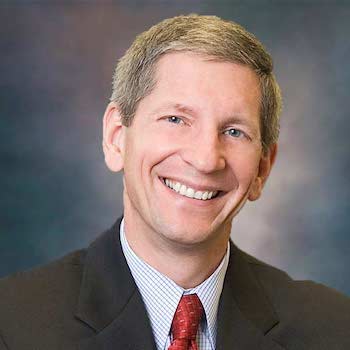Location
3007 Phoenix
Biography
We’ve all seen the everyday corrosive effects of things like wind, water and oxygen. They bring erosion, rust, rot. Eventually the exposed materials deteriorate and fall apart.
But what kind of material can stand up to the conditions inside a nuclear reactor? The extreme heat and pressure. Corrosive coolants. High radiation levels.
Finding out can be a slow and expensive endeavor, since a decade of damage takes a decade to replicate in a test reactor. By the time you find an answer to one question, the original problem is 10 years worse.
Gary Was, the Walter J. Weber, Jr. Professor of Sustainable Energy, Environmental and Earth Systems Engineering, believes there’s a faster, less expensive route to developing better reactor materials. He’s spent most of his career building Michigan’s nuclear materials lab into a place where he can prove it. His work helps maintain and improve the nuclear reactors that provide abundant, clean energy around the world.
Radiation speeds up corrosion, and – when combined with other stresses – causes tiny cracks in certain alloys used inside reactors. That damage can cause other, more expensive, equipment to fail, so the reactor has to be shut down while the alloys are repaired or replaced. That costs power companies a lot of money in lost production.
The Michigan Ion Beam Laboratory lets researchers shoot beams of electrically charged atoms, or ions, at a material in a way that simulates the radiation effects of a nuclear reactor. Using ion beams, Was and his team have shown they can replicate a decade’s worth of nuclear wear and tear in just a few days.
“Building capabilities has been an important part of shaping the research I do,” said Was, a professor in the departments of Nuclear Engineering and Radiation Sciences and Materials Science and Engineering. “For one thing it opens up the span of problems you can attack. And when students walk out of here they can walk into any other lab and say, ‘I’ve seen that stuff’ or ‘We have better.’ They’re not bowled over. They’re not intimidated.”
The Ion Beam Lab opened in 1986, six years after Was joined the faculty. When the latest expansion is finished in the summer of 2015 it’ll be the best facility of its kind in the world, with three particle accelerators configured to conduct experiments with more versatility and at greater extremes. He believes it’s the kind of lab Michigan must have – equipment on par with what you’d find in one of the national labs, combined with easier access and 24/7 operation.
A Detroit native, Was did his undergraduate studies at Michigan, landing in the College of Engineering somewhat by accident after missing a deadline for Naval ROTC. He chose nuclear engineering because it sounded different and futuristic, and four decades of work has done nothing to quench his curiosity. Because his work spans the effects of both radiation and other environmental stressors, Was tends to explore questions others don’t consider.
For years, he says, when he presented his ideas at conferences some older scientist would stand up and say, “That’s really nice, but there’s no way you’re ever going to convince me that you can understand what’s going on in a reactor by hitting it with ions. You’ve got to use reactor radiation.”
“Today it’s amazing because you go to these meetings and there are all these people talking about using ions,” Was said.
He jokes that maybe the objectors are finally retiring, but the nuclear power industry also appears to be on board. In 2014 Michigan landed a $2.4M international research project, sponsored by the Department of Energy and Electrical Power Research Institute. The Advanced Radiation Resistant Materials project will use Was’s ion beam techniques to test different alloys for reactor-worthiness, with most of the phase 1 work being done at Michigan.
“I feel we’re at the top of the heap as far as pushing that envelope,” he said. “If this works, we’ll accelerate the development of materials in the field by orders of magnitude. That’s a huge, huge game-changer in my mind.”
News
-
Gary Was honored by The Minerals, Metals & Materials Society
-
NERS and MIBL launch new fusion materials programs
-
Kevin Field and Stephen Raiman named new directors of NERS materials labs
-
NERS faculty receive $6.5M in DOE funding awards
-
NERS faculty receive $5.1M in DOE funding awards
-
Nuclear “shadow corrosion” reproduced in the lab, paving way to longer fuel life
-
Gary Was retires after 41-year career in materials and nuclear energy systems
-
Faculty books
Education
Massachusetts Institute of Technology
ScD Nuclear Materials ’80
MS Nuclear Engineering ’77
University of Michigan
BS Nuclear Engineering ’75
Research Interests
- Materials for advanced nuclear energy systems
- Corrosion
- High-temperature oxidation
- Stress corrosion cracking
- Hydrogen embrittlement
- Surface modification of materials
- Radiation effects, ion implantation
- Ion-assisted deposition, nuclear fuels.
Materials & Radiation Effects
Awards
- Fellow, Materials Research Society, 2011
- Special Achievement Award, American Nuclear Society, MSTD, 2008
- ASM Henry Marion Howe Medal for 2008
- Member, National Academies committee on Assessing Corrosion Education in the US
- Walter J. Weber, Jr. Professor of Sustainable Energy, Environmental and Earth Systems Engineering
- Outstanding Faculty Member Award, Nuclear Engineering and Radiological Sciences, 2006-07
- Significant Achievement Award, American Nuclear Society, MSTD, 2004
- 2000 Champion H. Matthewson Medal, TMS
- Fellow, American Nuclear Society, NACE International, ASM International
- Teacher of the Year Award, selected by the students of NERS, 1998
- Excellence in Research Award, College of Engineering, 1994
- Presidential Young Investigator, National Science Foundation
